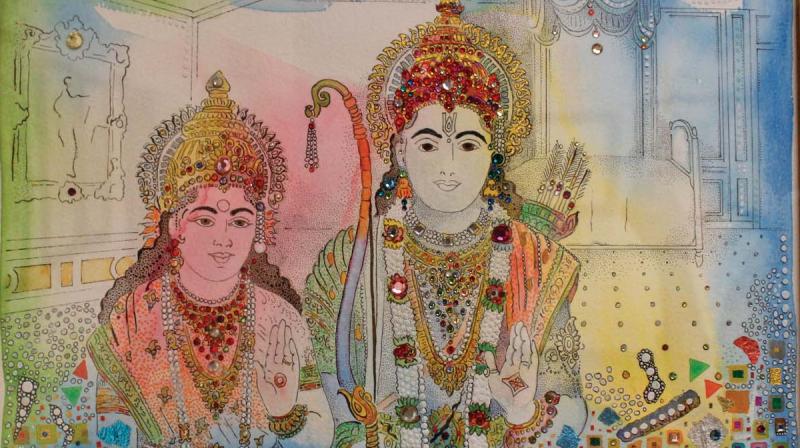Hindu mythology bowls Paris artist over

Once the French artist came to be familiar with the fascinating stories of Hindu mythology and their context, he felt that there had to be some connection amid his vast artwork and the country’s traditions. His exhibition, which is going on in DakshinaChitra, shows some of the artist’s creations of symbolic abstracts.
Olaf Van Cleef, the artist, author and traveller, belongs to the famous Van Cleef family of Paris, dealing in the business of jewels for centuries. The artist has been seen wearing three pairs of spectacles, one over the other, while painting and giving magnificent touches of vibrant colours, dotted with white paint, using the finest brushes. The 3D effect that he embosses using precious stones in his paintings is what sets him apart from other artists. There are other features in his artworks that are boosted by the subtle use of metallic papers of different colours.
Q Most of your paintings are based on Indian mythology theme. Why?
At a very young age I was impressed by the high importance given to jewellery in India. The Gods, princes and princesses were all wearing them. Everything which is different seems to be very interesting and that is the story of the jewellery which pushed me into Indian art. With time, I learnt the stories of Hindu mythology and I started painting in European style, like Ganesh and the king of France, Louis XIV.
Q When did you think about merging these two cultures?
India entered in my art life when I discovered Raja Ravi Varma. It was a throwback to the day when I entered a temple in Pondicherry and I discovered one little old painting of Lakshmi, done in English style with several colour stones intricately placed in the work. Especially, the lotus was covered with stones like the eggs of small birds. It was at that time that I had the idea of mixing European culture with Hindu mythology.
Q How’s your first exhibition experience and the time when you sold your first painting?
My first exhibition was in Chennai in 2005 but my first painting was sold in 2008 in Mumbai. When Pheroza Godrej and her sister-in-law came to me and asked about my Ganesha artworks for Diwali. I decided to take inspiration from several Indian painters like Paritosh Sen, Asma Menon and Jaminy Roy. Sometimes I think I would like to be more Indian and learn more.
Q What would you like to say to future painters?
I must tell aspiring artists that art has to be three things: Reality, Symbolic and Imagination. Reality is the subject and technique of the art should reflect in the artwork. Symbolic is the message of the painting, the message not only from the painting but also the message of the artist and the first message is “I do my best for you to put in your dreams.” Imagination is the crystallisation with the stones, the crystal and the different colours of gold.
Q Is there any other theme that you are focusing on?
If somebody asks me for a single choice, I would love to paint more elephants and rhinoceroses.
Q Is there any specific reason behind your choice of theme for this exhibition?
DakshinaChitra is unique and I have a lot of admiration for the ideas of Deborah Thiagaragan. It was a great honour to exhibit in this place. While showing a work, an artist also gives a message to the masses. I wanted to explain by my work how the Indian culture is very important in Europe and especially in France.
Q Who played the important roles in your journey as a mentor?
Two mentors: My guide was Soli Godrej. I had the privilege to be his friend during the last 15 years of his life. He taught me what is India and its cities.
The other one was Vincent Van Gogh, my cousin; but he taught me by the force of his brushes. The technique was so important in one work, sometimes I used to take 300 hours to complete one piece and when I felt the final is not that good I used to destroy those pieces.

